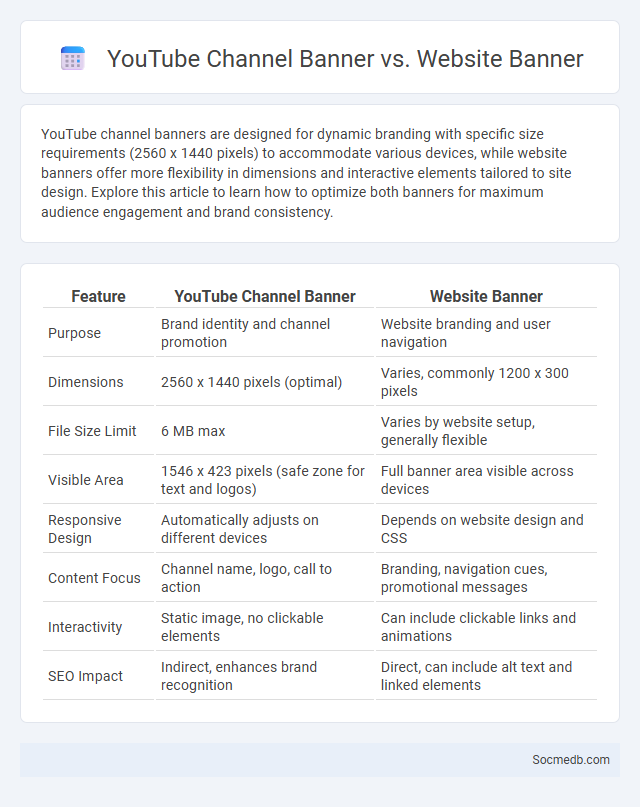
Photo illustration: YouTube Channel Banner vs Website Banner
YouTube channel banners are designed for dynamic branding with specific size requirements (2560 x 1440 pixels) to accommodate various devices, while website banners offer more flexibility in dimensions and interactive elements tailored to site design. Explore this article to learn how to optimize both banners for maximum audience engagement and brand consistency.
Table of Comparison
| Feature | YouTube Channel Banner | Website Banner |
|---|---|---|
| Purpose | Brand identity and channel promotion | Website branding and user navigation |
| Dimensions | 2560 x 1440 pixels (optimal) | Varies, commonly 1200 x 300 pixels |
| File Size Limit | 6 MB max | Varies by website setup, generally flexible |
| Visible Area | 1546 x 423 pixels (safe zone for text and logos) | Full banner area visible across devices |
| Responsive Design | Automatically adjusts on different devices | Depends on website design and CSS |
| Content Focus | Channel name, logo, call to action | Branding, navigation cues, promotional messages |
| Interactivity | Static image, no clickable elements | Can include clickable links and animations |
| SEO Impact | Indirect, enhances brand recognition | Direct, can include alt text and linked elements |
Understanding YouTube Channel Banners
Your YouTube channel banner is a crucial visual element that enhances your brand identity and engages viewers by showcasing your content style and personality. Optimizing the banner with appropriate dimensions (2560 x 1440 pixels) ensures it displays correctly across all devices, while incorporating clear visuals and concise text improves viewer recognition and retention. By understanding the importance of strategic design and placement, you can effectively attract and maintain your target audience on your YouTube channel.
What is a Website Banner?
A website banner is a prominent graphic element displayed at the top or side of a webpage, designed to capture Your attention and convey key messages or promotions. It often includes images, text, and calls to action, optimized for both visual appeal and engagement metrics. Effective website banners are strategic tools in social media marketing, driving traffic and enhancing brand visibility through targeted content.
Defining Channel Banners Across Platforms
Channel banners serve as the visual cornerstone of your social media profile, designed to convey brand identity and capture audience attention across platforms like YouTube, Facebook, and Twitter. Optimal banner dimensions vary, with YouTube recommending 2560 x 1440 pixels and Facebook suggesting 820 x 312 pixels to ensure clarity on all devices. Tailoring your channel banner's design and messaging to each platform enhances user engagement and strengthens your brand's online presence.
Key Differences: YouTube Banner vs Website Banner
YouTube banners are designed with a 2560 x 1440 pixel dimension and primarily focus on mobile, tablet, and desktop visibility, while website banners vary widely in size but commonly measure around 1920 x 600 pixels, optimized for faster loading and responsiveness. YouTube banners prioritize branding and channel promotion within strict content policies, whereas website banners emphasize call-to-action elements and SEO-friendly graphics to enhance user engagement and search engine rankings. The interactive capabilities of website banners often surpass YouTube's static or animated formats, enabling dynamic advertisements and personalized user experiences.
Banner Dimensions and Design Requirements
Effective social media banner dimensions vary by platform, with Facebook requiring 820 x 312 pixels, Twitter 1500 x 500 pixels, and LinkedIn 1128 x 191 pixels for optimal display. Your banner design must prioritize high-resolution images, clear typography, and brand consistency to ensure visual impact across devices. Incorporate concise messaging and balanced whitespace to enhance engagement and readability on all social media channels.
Visual Impact: Channel Banners vs Website Banners
Channel banners on social media deliver an immediate visual impact by showcasing your brand's personality and key messages prominently across platforms like YouTube or Facebook. Website banners complement this by providing targeted information and calls to action that guide visitors through your site's content, enhancing user engagement. Your cohesive use of both banner types maximizes brand recognition and drives conversions effectively.
Optimization Tips for YouTube Channel Banners
YouTube channel banners should feature high-resolution images sized at 2560 x 1440 pixels to ensure optimal display across devices. Incorporate clear branding elements such as logos and channel names within the central "safe area" of 1546 x 423 pixels to prevent cropping on different screens. Use bold, readable fonts and consistent color schemes to enhance visual appeal and strengthen brand recognition.
Website Banner Best Practices
Effective website banner design boosts user engagement through clear messaging, high-quality visuals, and strong calls-to-action. Incorporating responsive design ensures banners display correctly across all devices, while leveraging A/B testing optimizes performance based on user interaction data. Prioritizing fast loading times and minimal text improves user experience and click-through rates on social media platforms.
Importance of Branding with Channel Banners
Channel banners are a critical element of social media branding that visually communicate your identity and values to your audience. A well-designed banner enhances recognition, making your channel instantly identifiable and fostering trust with viewers. Your consistent use of unique colors, logos, and messaging in the banner strengthens brand awareness and encourages user engagement across platforms.
Choosing the Right Banner for Your Goals
Selecting the right social media banner involves aligning the design with your brand's identity and marketing objectives, ensuring it captures attention while conveying a clear message. Optimal banner dimensions vary across platforms--such as 820 x 312 pixels for Facebook cover photos and 1500 x 500 pixels for Twitter headers--maximizing visual impact without losing resolution. Use bold, high-contrast imagery and concise text to enhance engagement and drive clicks tailored to your campaign goals.
 socmedb.com
socmedb.com